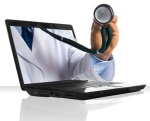“Wherever the art of Medicine is loved, there is also a love of Humanity.” ― Hippocrates
 By: Shobha Lizaso
By: Shobha Lizaso
The need for healthcare services is growing at an exponential rate throughout the US and across the world while the number of healthcare providers is dwindling in comparison which paves the perfect way for telemedicine. The ease of healthcare access should be standard for all people, but many go without healthcare because of their geographic location or lack of funds. From these circumstances, technology has risen as the new champion for the provision of healthcare; technology is building necessary connections between healthcare providers and patients through telemedicine. The field of telemedicine complements traditional medical care in various ways already, and it is expected to continue to expand through the healthcare industry. Some current uses are as follows:
- To bring healthcare services to patients in distant locations by allowing healthcare providers and healthcare facilities expand their practice beyond their physical offices. For example, telemedicine has the capacity of connecting healthcare providers with patients living in rural and remote places of the world, increasing a practice’s reach by potentially millions of patients.
- To reduce the cost of health care due to lowered practice operational overhead costs, shared health professional staffing, reduced travel times, and fewer or shorter hospital stays.
- For easy follow ups with patients and ongoing care for patients who live in remote areas, who don’t have easy access to transportation, or who are primarily home bound.
- To provide healthcare to those affected by disasters or during emergency situations.
Business Structure for Telemedicine
Telemedicine can be structured in various ways to best serve both the patient and the healthcare provider:
- Remote patient monitoring (RPM) allows healthcare providers to track a patient’s vital signs and other health data from a distance. RPM can make it possible to quickly intervene in emergencies of patients who have health risks or are recovering from a recent surgery. RPM is used to record and transmit patient medical data automatically, generating a regular report for the physician. In addition, this medical data may be transmitted to a team of health monitoring professionals who are responsible for identifying any warning signs and sending them on to the physician for further review.
- Store-and-forward telemedicine removes the need for the healthcare provider to meet in person with a patient because data such as medical images can be sent to the provider as needed when it has been acquired from the patient. This method is commonly utilized in the areas of dermatology and pathology, among others.
- Real-time telemedicine is a live interaction between either a healthcare provider and patient, or between healthcare providers, using audio and video communication.
Health is fundamental to all life. The path that technology is paving through telemedicine has the potential to minimize healthcare costs, make healthcare more available, and to raise the standards for all of humanity.
Shobha Lizaso is serving as legal counsel to the Maniapure Foundation USA, a non-profit organization that is determined to bring telemedicine based healthcare to over 10,000 people living in remote areas of Venezuela.
